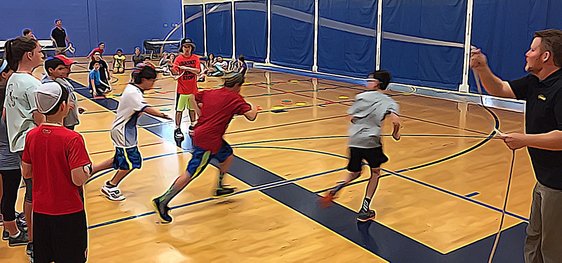- Ask the group to see if they can all get through the spinning rope from one side to the other.
- Go through the spinning rope one person at a time.
- Make one jump as the rope turns and move out.
- Don't miss a beat of the rope between people.
- If anyone hesitates and the rope makes a turn without anyone in there to jump, the entire group must begin again.
Recently I was reintroduced to turnstile done in a new way (by my friends at Group Dynamix). The facilitator has a wide variety of challenges he/she can present to a group based on their readiness. In other words the range of challenges spans from easy to more difficult. Before I share my every-growing list of challenges with you there are several things you need to know: .
- The entire group starts on one side of the rope and is challenged to get to the other side (like the original version of The Turnstile).
- When the rope is turned it is moving away from the group as it moves across the floor/ground.
- I (the facilitator) am one of the turners, a group member is the other.
- I will control the speed of the turn and will "help" when I can to "manage" the rope when it might cause a problem (e.g., if someone gets caught in the rope I will let go).
- If someone touches the rope or there is a "miss" related to the challenge, I (the facilitator) stop the rope from turning. A "start over" is required.
- "Everyone" includes the rope turner from the group - so this is a "problem" the group must (first figure out and then) solve. .
- Participants are allowed to return to the starting side of the rope to go through the rope again in order to help others complete the challenge.
- If anyone touches the rope while going through the rope stops turning - everyone starts the challenge over.
- When the parameters of a challenge have been satisfied the rope stops, we all cheer, and return to the starting side of the rope for the next challenge (if there is time).
- Working through the challenges for more than 20 minutes is very tiring for the facilitator - start your training early and eat a good breakfast! Encourage the group to change turners often.
- I've done this activity with 4th graders (the first handful on the list) and older.
- Everyone moves to the others side one person at a time. (No jumps, not consecutive.)
- Everyone moves to the other side with a partner. (No jumps, not consecutive.)
- Everyone moves to the other side in a group of three. (No jumps, not consecutive.)
- The group (everyone) has 10 turns of the rope to get to the other side - the first turn that is counted is the first turn passed through by one or more participants. (No jumps.)
- Everyone moves to the other side one at a time - someone must go through the rope during each turn. (No jumps.)
- Everyone moves to the other side with a partner - a pair must go through the rope during each turn. (No jumps.)
- Everyone moves to the other side in a group of three - a group must go through the rope during each turn. (No jumps.)
- Everyone in the group moves through the rope consecutively in this order of participants - 1, 2, 3, 4, 5, 4, 3, 2, 1. (No Jumps.)
- Everyone in the group alternates between going through the turn and jumping the turn - one goes through, the next must jump the rope once, the next goes through, the next jumps once and so on. (Not consecutive.)
- Everyone in the group alternates going through the rope (not jumping) in pairs followed by a single jumper then two through, then a single jumper and so on. (Not consecutive.)
- Participants alternate consecutively between going through the turn and jumping the turn - one goes through, the next must jump the rope once, the next goes through, the next person jumps once and so on. There must be someone going through or jumping during each turn of the rope.
Okay, over the next week or so let's add to this list of challenges. Include your challenge in the Comments below or direct email me and I'll put them into this "ever-growing" list.
Chris Cavert, Ed.D.







 RSS Feed
RSS Feed